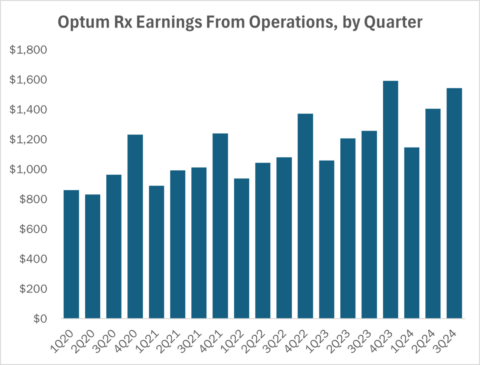I’m down in Miami this week for the Drug Channels Leadership Forum. If you’re here, say hi at the reception tonight. If you have a colleague that’s here, let me know and I’ll track ‘em down. And if you’re feeling FOMO, email me for my real thoughts about Florida in March.
Pretty pumped for the program, though.
INFLECTION POINT/ The Middlemen Come for 340B
Here’s a question: What’s the purpose of 340B?
It’s not an easy question.
Ask a manufacturer, and the answer will veer toward the idea that 340B is intended to deliver low-cost medicines directly to struggling patients. A provider might argue that the program is a no-strings-attached subsidy for safety-net providers. Old-timers will talk about a mandate to “stretch scarce federal resources as far as possible.”
Still, all of those answers suggest that 340B is designed to support vulnerable Americans, and the battle is really about how direct the “support” ought to be.
No one thinks that the purpose of 340B is to deliver cheap meds to commercially insured patients.
But because the law itself is so vague and the oversight so lax and blind to the way it creates perverse incentives, there is not a cottage industry of for-profit firms working to divert 340B medicines to employers.
All of this is detailed in a great and ambitious Wall Street Journal piece by Joe Walker, and, if you haven’t read it already, you should stop what you’re doing and go and read it. It’ll save me a lot of time summarizing it.
What Joe lays out is abuse, plain and simple. Don’t take my word for it. Here’s Adam Fein from the story: “It is a blatant abuse of the program.”
I get that there is an argument that is all technically permissible under a broad reading of the law and regs, but that’s cold comfort to people who believe in the mission of 340B. This is not how the program is supposed to work.
Indeed, the WSJ makes clear that none of the people who are supposed to benefit see much gain from this model: The hospitals get a little more volume, but they don’t even share directly in the spoils.
The story implies that this isn’t a super-popular strategy quite yet, and I can see why. I’m not sure the payoff for hospitals — more patients — is necessarily such a plus that it makes up for the fact that they don’t profit off of the spread.
Plus, this kind of abuse is going to lead to more calls for reform, probably in ways that harm covered entities.
Of course, the worst-case scenario is that this kind of abuse leads to a world in which pharma companies just opt out of 340B (and, therefore, Medicare and Medicaid) as a way to circumvent the abuse. I don’t think that’s likely, in the near term, and it’s not an outcome that anyone wants.
But 340B has been a tale of ever-increasing abuse in ways that aren’t benefitting needy patients one whit. The WSJ story shows that there is a line of smart folks just looking for ways to skim off the top.
The natural question to follow, “What’s the purpose of 340B?” is “What can we do to restore that purpose?” Because 340B is degenerating in a way that no one wants.
THE ARC: Dr. Oz Goes to Washington
Back in the fall, I wrote a snarky newsletter when Mehmet Oz was nominated to lead CMS. My knee-jerk reaction was that Oz probably had two fatal flaws. He didn’t have experience running a huge bureaucracy, and it wasn’t obvious that he knew jack about CMS.
The second point may have been hasty.
Looking back over Oz’s testimony on Friday, he seemed to be conversant with a lot of the CMS items that I’m most focused on. I still don’t think he’s the second coming of Mark McClellan, but here’s how he handled certain topics:
On PBMs:
On gene therapy economics:
On drug-pricing regulation:
And
None of those answers are necessarily iron-clad commitments to do (or not do) anything. But they do get me one step closer to retiring the “nobody knows” GIF. I read this as provisional support for continued price controls and a confirmation that international reference pricing remains on the table.
What will the actual policy decisions end up being?
Actually, maybe I can’t retire the GIF quite yet.
QUICK TURNS/ A Great 340B Analysis, a Pfizer Pivot, and New Reasons to Throw a Patent-Burning Party
This is a nice newsletter edition from Matt Stoller that looks at why Walgreens ultimately ended up flailing so badly that private equity had to swoop in. It notes that a lot of lay media are missing the point: the existential problem with Walgreens isn’t really the number of stores or “bad management.” It’s that PBMs degraded the core business of selling medications so badly that the company was pretty much doomed. Not news to you all, but a nice effort to correct the conventional wisdom.
This is a really good white paper on 340B from the American Cancer Society’s Cancer Action Network. It has some new math in it … the group calculated what the 340B profits were on Medicare sales alone, and it came up with a $21 billion number. Keep in mind that Medicare profits are capped by a very modest markup. Commercial profits are not. So $21 billion is just the tip of the iceberg. There are tons of other great stats in there, too. I know it’s a busy week, so just print it out and make sure you read it later.
One of the less-hip controversies around the implementation of the IRA is the reality that no one is entirely sure how — from a technical, operational POV — independent and franchise pharmacies will be made whole when they dispense “negotiated” medicines. Avalere has a new analysis that quantifies this issue. About 30% of scripts flow through retail pharmacies, though there is a ton of variation between states.
CMS has announced that all manufacturers are going to participate in the next round of “negotiations.” Not a shock. If you want to look for hidden meaning here, it might be that the Trump administration is picking up the Biden habit of crowing about every procedural milestone here.
Pfizer is overhauling its sales strategy, per Jared Hopkins at the Wall Street Journal. Among the company’s approaches? A focus on tackling access barriers head-on. Who knew that was such a problem? /s
This is a useful reference from Fierce on the big drugs losing exclusivity this year. I still think that industry should throw a patent-burning party to celebrate these traditions, as Peter Kolchinsky once suggested. If your company ever wants to do that sort of thing, I’ll do the PR for free.
Cost Curve is produced by Reid Strategic, a consultancy that helps companies and organizations in life sciences communicate more clearly and more loudly about issues of value, access, and pricing. We offer a range of services, from strategic planning to tactical execution, designed to shatter the complexity that hampers constructive conversations.
To learn more about how Reid Strategic can help you, email Brian Reid at brian@reidstrategic.com.





